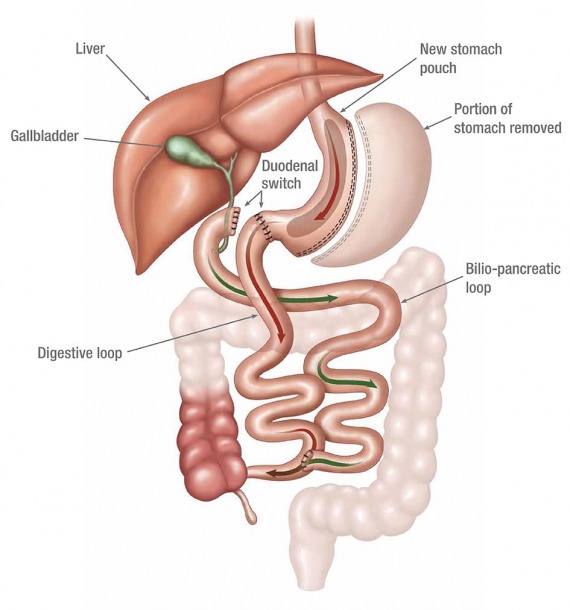The biliopancreatic diversion with duodenal switch (BPD/DS) is a well established weight loss surgical procedure that provides excellent weight loss and long term resolution of health conditions associated with obesity. This duodenal switch is usually, but not always, reserved for the extremely obese (with a BMI of greater than 50) because this surgery tends to produce greater amounts of weight loss compared to other weight loss procedure—patients could lose from 60-85% of excess body weight!
So here’s how a duodenal switch works. It can get kind of confusing, but hang in there! This procedure can be done open or laparoscopic, although laparoscopic is much more likely. In the open procedure, your surgeon would make one large cut in your abdomen. Laparoscopic requires your surgeon to make a few small incisions into your abdomen where the laparoscope and surgical instruments are inserted.
The duodenal switch has three different steps to it. First, the size of your stomach will be reduced. Basically, a sleeve gastrectomy is preformed where a portion of your stomach will be removed, leaving a narrow tube (or sleeve) from the top to near the bottom of your stomach. This will reduce the amount of food you can eat at one time, as we have learned before, resulting in weight loss. But that’s not all. Next, the natural path of digestion is rerouted. Food is directed away from the upper part of the small intestine (the duodenum). The duodenum is divided just past the outlet of the stomach, and then the last portion of the small intestine (the distal) is then brought up and connected to the new outlet created in the new “sleeve” stomach.
So now, when you eat, food will travel through the new narrow stomach and dump directly into the last portion of the small intestine—bypassing roughly three-fourths of the small intestine. This cuts back on how many calories and nutrients you absorb significantly, which also aids in weight loss. And lastly, the bypassed part of the small intestine (which carries bile and pancreatic enzymes which are essential for protein and fat breakdown and absorption) is reconnected to the last portion of the small intestine—because you need those enzymes and bile! This way the bile and enzymes can eventually mix back into the food stream. However, with the rerouting the normal way these enzymes and bile break down food in changed and the amount produced is changed. Therefore, even more weight loss will result. So, you will find weight loss because your stomach is smaller, your small intestine is rerouted, and because your digestive juices are altered.
Now, let’s talk about recovery. Although the duodenal switch is a larger and more complex procedure, your hospital stay should still only be 2-3 days. And like the other surgeries we’ve discussed, you will start on a clear liquid diet, progress to pureed foods, and the slowly incorporate solid foods. There is a number of vitamin and mineral supplements you will need to take, along with making sure you get plenty of protein in your meals. Talk with a dietician, and make sure to follow the dietary guidelines post surgery or you could experience diarrhea and/or excessive gas.
Lastly, let’s discuss the pros and cons of the duodenal switch. Some cons: BPD/DS greatly reduces the amount of vitamins and minerals you absorb which could lead to serious, long term deficiencies and complications. Few have experience protein malnutrition, which can be potentially life threatening. Abdominal bloating and malodorous stool and gas may occur. Changes in the intestines could lead to gall stones and maybe even gallbladder removal. And also, loose and frequent stools may occur in the beginning, although few patients experience lifelong altered stools. Some pros to this procedure are: this surgery can produce the highest amount of weight loss compared to other weight loss surgeries (in one study of 125 BPD/DS patients, excess weight loss of 74% at one year, 78% at two years, 81% at three years, 84% at four years, and 91% at 5 years was achieved!). And one of the main advantages to this surgery is that patients are able to eat larger meals compared to dietary restrictions put on the other weight loss procedures. Patient satisfaction is among the highest of all weight loss procedures.
As you can tell, each weight loss procedure has definite pros and cons. The decision to have weight loss surgery is not an easy one, and then deciding WHICH procedure to have can be even more complicated! Talk to your health care provider. Talk to supportive loved ones. This is a life altering decision, make sure it is the right one for you.
Are you a candidate? Start here
Intro: Should I consider weight loss surgery?
Series article #2: Gastric Bypass Surgery – Everything you want to know (and more)
Series article #3: Sleeve Gastrectomy – Everything you want to know (and more)
Series article #4: The Duodenal Switch (DS) – Everything You Want to Know (and more)



